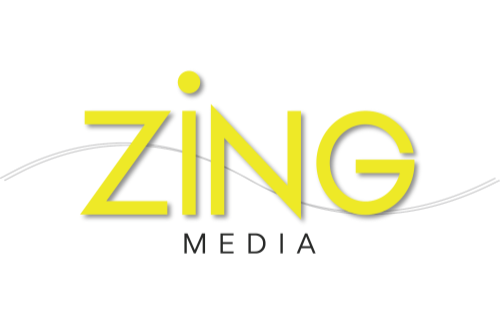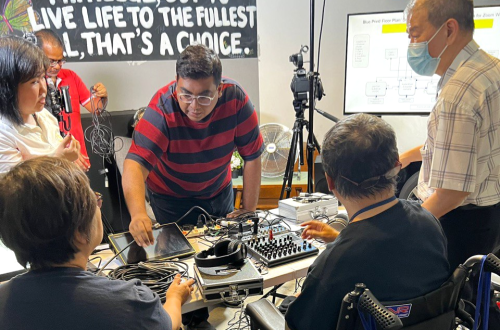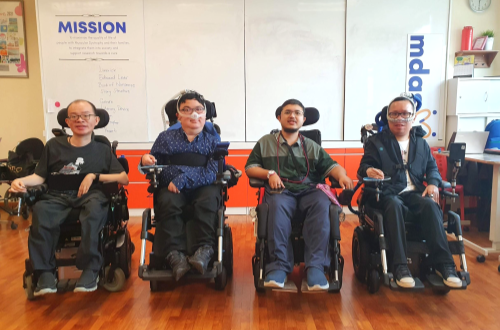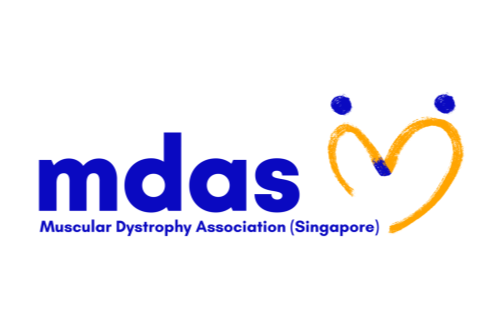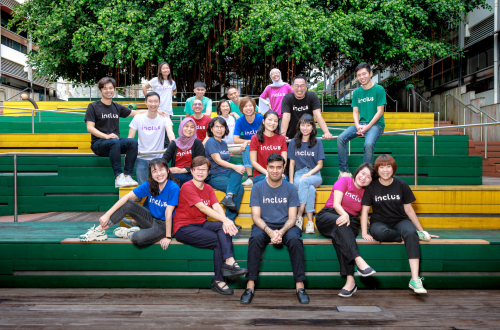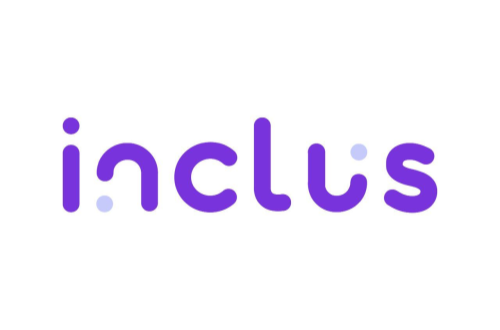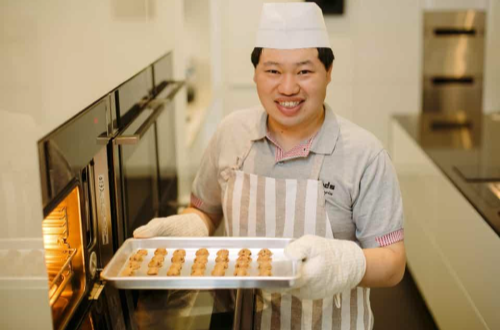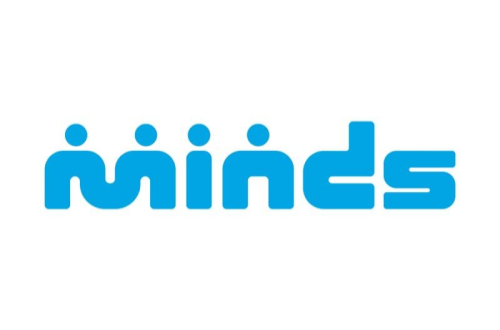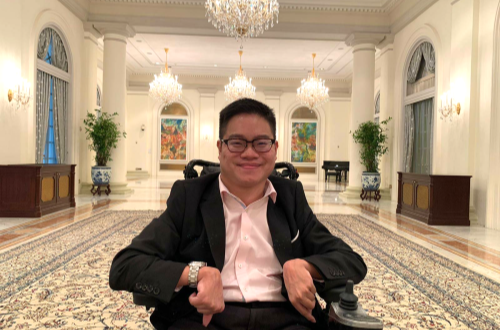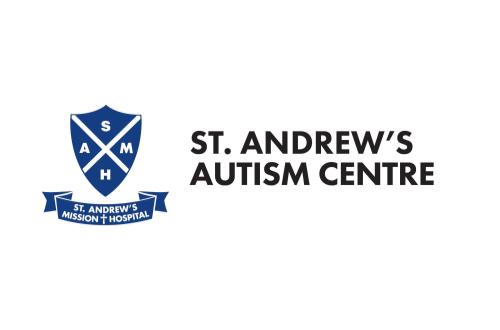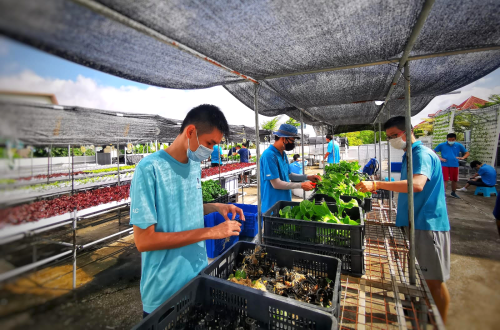2023 Teams
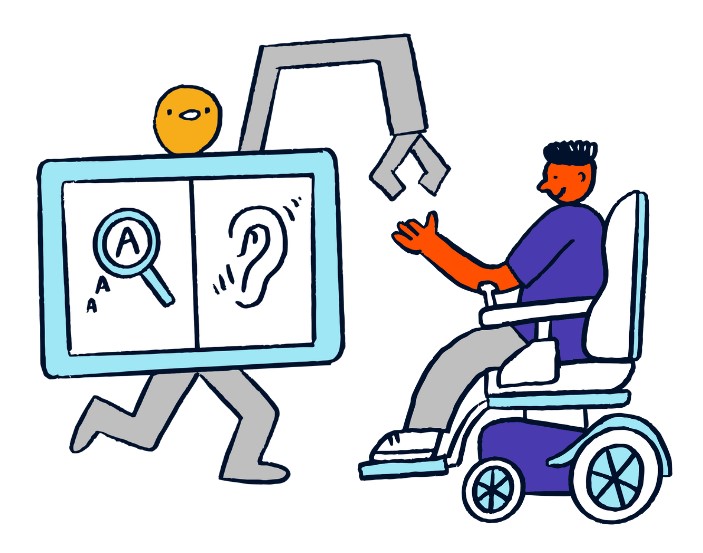
It takes a village to create meaningful change.
Engineering Good and the T4G teams are proud to partner with these six communities that share our mission of using technology for good!
Team MediAbility
How might we make camera operation more user-friendly for individuals with limited strength and range of motion?
Team MiDAS
How might we make watercolouring and drawing independent, precise, and intuitive for people with Muscular Dystrophy?
Team Inclusivertec
How might we create a safe space for PwDs to regulate and communicate their emotions, enabling them to receive personalised support from Inclus?
Team Scale Up
How might we simplify the premixing process so that baking is made accessible to a wider range of participants with intellectual disabilities?
Team Wzeals
How might we empower persons with physical disabilities to effortlessly navigate the barriers along their daily commutes with low-tech and accessible solutions?
Team SAAC Farmers
How might we make the seeding process for germination more efficient and autism-friendly?
Wheelchair Photography Platform
by Team MediAbility
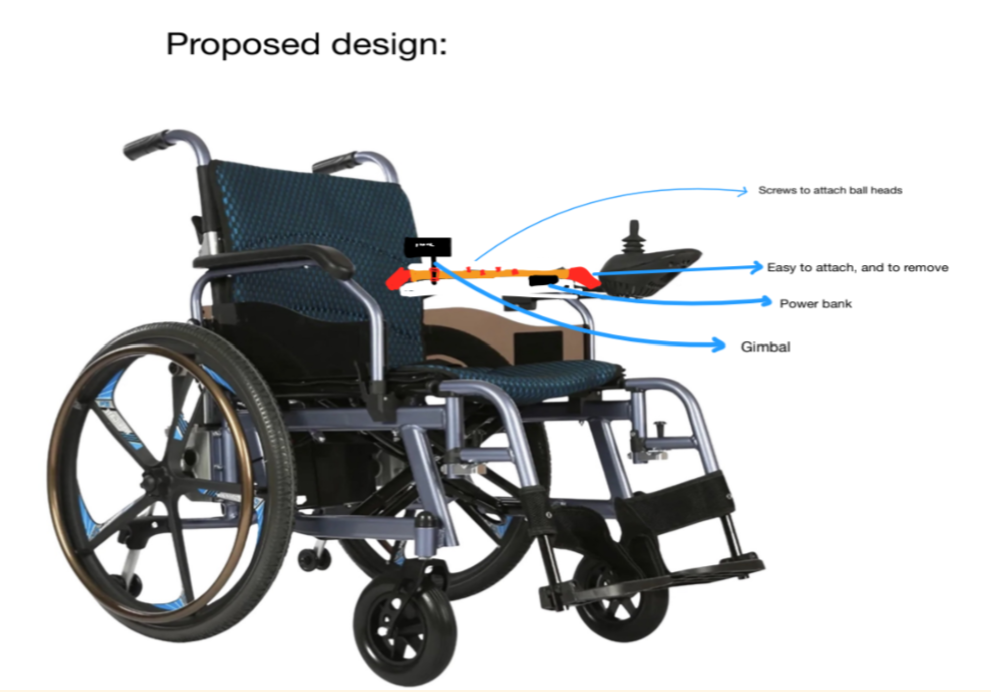
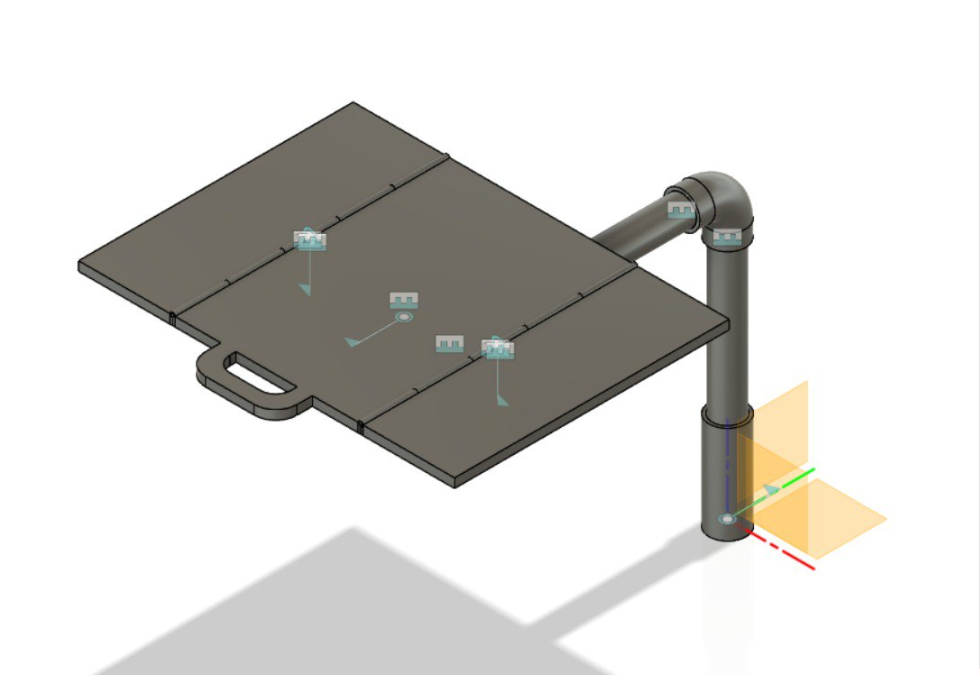
How might we make camera operation more user-friendly for individuals with limited strength and range of motion?
Our team: Amrita, Kenzie, Manash, Swasti, Yu Quan
Our mentor: Singaram
Project Vision:
Imagine a camera mechanism that is so fluid that you only require one hand to pan, tilt, and zoom. The mechanism would sit firmly on the user’s wheelchair, enabling them to capture their desired shot while freely moving their wheelchair. With a camera mount designed specifically for wheelchairs, more people who use wheelchairs can find employment or enjoy content creation!
Understanding Our Users:
Many stroke survivors experience weakness on one side of their body, and requires them to use creative ways to manipulate tools and equipment. Operating a camera and filming on the ground can be particularly challenging. Pressing buttons, adjusting settings, and stabilizing the device all at once require intricate dexterity and become a complex task on top of moving their wheelchairs. Additionally, holding a camera with one hand for long periods of time can cause fatigue as cameras are often heavy.
Current state:
There is a wide range of gimbals, cage mounts, and camera accessories on the market, as content creation is a fast-growing industry. Unfortunately, they are rarely adapted to people with physical disabilities. Customised solutions also come with various concerns. Wheelchairs come in a variety of shapes, sizes and fittings, and a customization to one wheelchair may not fit another. Customizations are also costly and require specialized skills, which may be hard to find.
New Innovative Design:
Our camera mount is designed to attach to the armrests of wheelchairs, utilizing the wheelchair as a stabilizer to support the weight of the camera and accessories. This allows the user to operate the camera with their dominant hand, while it sits directly in front of them. The mount has the flexibility to allow for easy attachment of accessories in a position suitable for the day’s filming assignment. It can be adjusted to fit a variety of wheelchair models and can be replaced during regular replacement cycles. With user safety as the primary concern, the mount can be easily ejected from its place without compromising security.
Community Partner: Zing Media
Zing Media has partnered with SG Enable to provide a media course to train persons with disabilities (PWDs) in areas such as producing, videography, video editing, and camera operation. These aspiring filmmakers include Pua Kia Fong, George Kanapathy, and Sereen Cheng. This trio shares the same aspiration of becoming camera operators in the film industry.
Operating a camera requires technical expertise, meticulousness, and excellent hand-eye coordination. The role can also be physically demanding—moving heavy equipment and enduring long hours on set. Therefore, people with physical disabilities have often been overlooked for this role, as their limited movement makes it difficult to move the camera and capture footage from different angles.
Innovators will work with aspiring creatives to make camera operating more accessible and increase job opportunities in the film industry for persons with physical disabilities!
Touch2Paint
by Team MiDAS
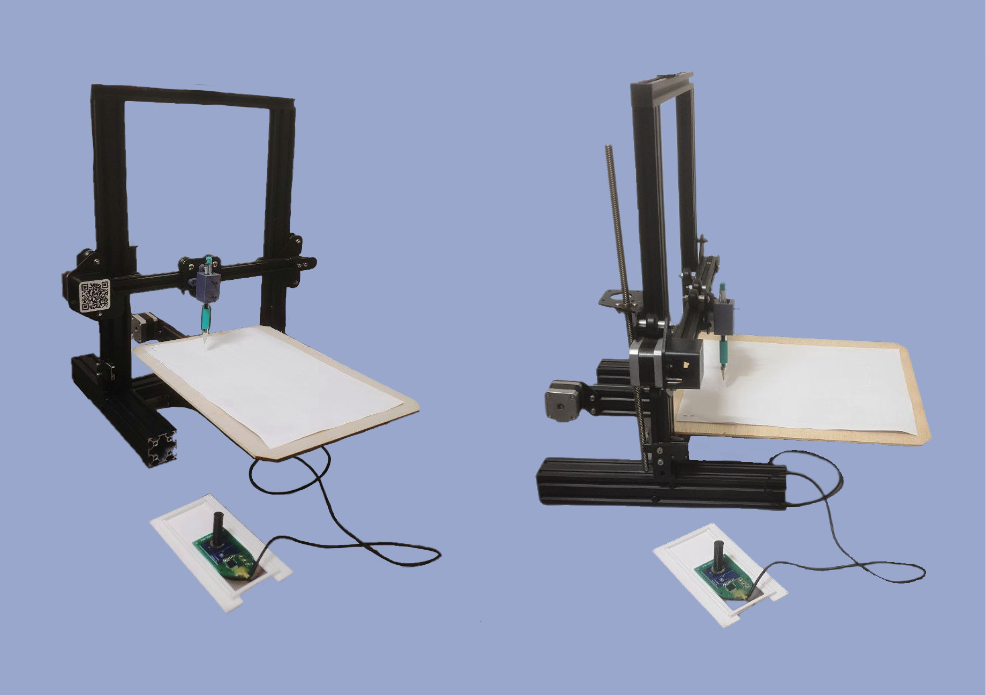
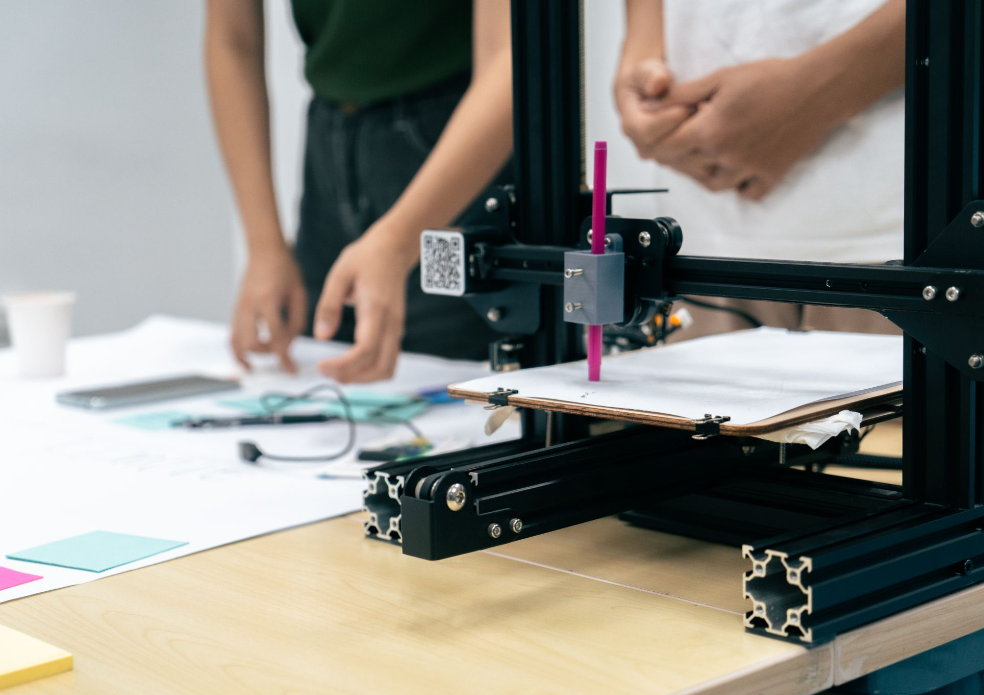
How can we make watercolouring and drawing independent, precise, and intuitive for people with Muscular Dystrophy?
Our team: Jessica, Elliot, Sahheeda, Jonathan, Advaitaa
Our mentor: Sufyan
Project Vision:
Our goal is to provide a unique and accessible avenue of self-expression for individuals with muscular dystrophy by hacking a 3D printer to draw and paint. By focusing on their creative abilities and giving them independent control of the pen, the possibilities for self-expression and creativity are limited only by the size of their canvas.
Understanding Our Users:
This group of friends is vibrant and expressive, enjoying various forms of art, such as design, photography, and writing. They are often full of inspiration, ready to put pen or paintbrush to paper. Despite muscular dystrophy affecting their strength and range of motion, they can control a micro joystick with precision and dexterity. Many of them are already skilled in using a micro joystick with ease, as they use it to operate their motorized wheelchairs. This was a key access point we used to begin creating our solution.
Current state:
MDAS conducts weekly art classes for our community partners, which include watercolour, marker, and other mediums. However, due to the various degrees of muscle control in their arms, wrists, and hands, the conventional tools used in the classes, such as paint brushes, water buckets, and palettes, can be challenging to use and unsuitable for extended periods of time. These tools limit the sensitivity and expression that our partners would like to achieve in their artwork.
New Innovative Design:
Can a 3D printer work in 2D? Absolutely! By attaching a drawing tool (pen or paintbrush) where the nozzle is, a repurposed 3D printer can use its mechanisms to draw on a sheet of paper. Moving the drawing tool on the x or y-axis will be controlled by a low-force joystick – perfect for those with varying degrees of muscle control. To draw or lift the pen or brush off the paper, simply press a light-touch button. That movement makes use of the 3D printer’s z-axis mechanism. It’s a game-changer for our friends with muscular dystrophy, as they can now paint or draw more independently during their weekly art classes.
Community Partner: Muscular Dystrophy Association Singapore (MDAS)
These four friends have a keen interest in developing assistive technology solutions for their community, participating in T4G for the third time. Each of them brings a unique perspective to innovating assistive technology: Timothy has a background in product design and innovation. Saifudeen is a graphic designer and artist. Boon Keng is a motivational speaker, digital marketer, and board member of MDAS. Shalom is an award-winning disability advocate and is currently a community partnership executive at K9 Assistance.
Timothy and Saifudeen are participants of the Bridge programme at MDAS, which aims to nurture and build the fundamental capacity of individuals with MD, gearing them towards pre-vocational training and eventually employment. As participants in the arts programme, they nurture a shared passion for the arts, with an impressive array of talents, including illustration, storytelling, painting, and design between them. Some challenges they face include weak upper body strength, making it difficult for them to paint and use conventional art and design tools.
Innovators will work with the group to explore fun ways of making art accessible for people living with Muscular Dystrophy.
Inclus App
by Team Inclusivertec
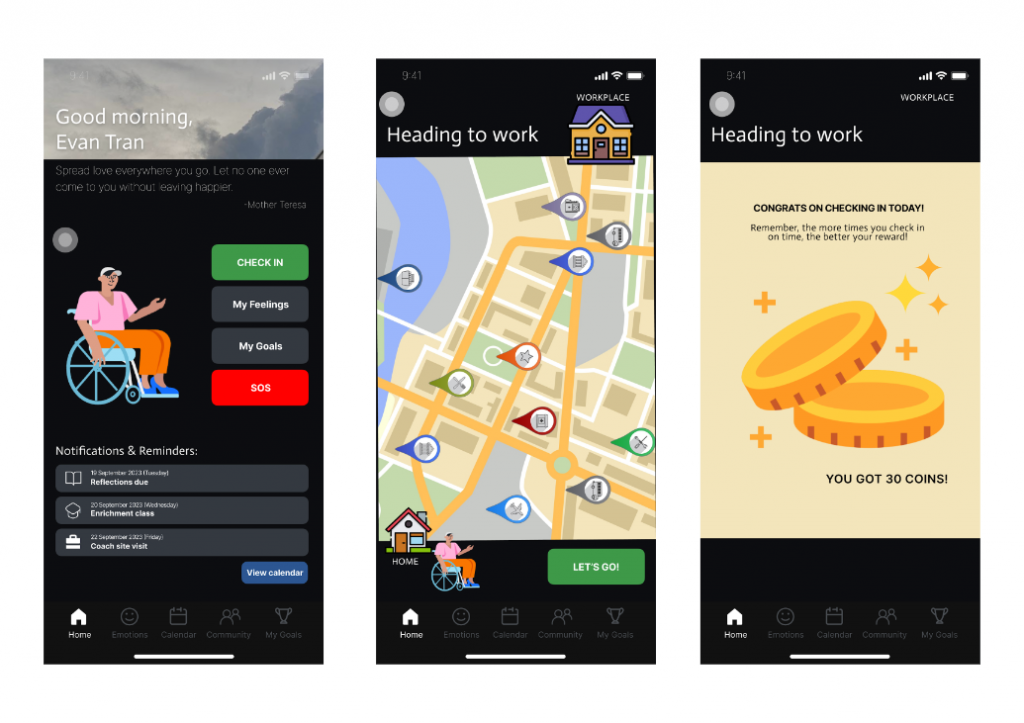
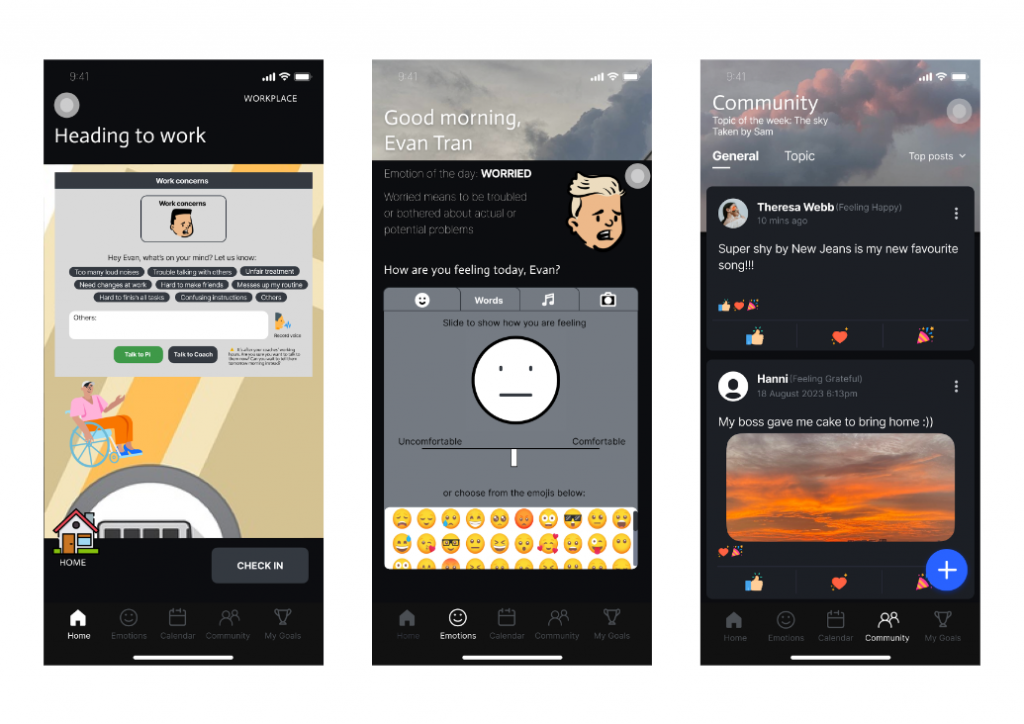
How might we create a safe space for PwDs to regulate and communicate their emotions, enabling them to receive personalised support from Inclus to reduce on-site support while respecting the boundaries of all involved?
Our team: Beatrice, Samuel, Roy, Rishika, Hong Xun
Our mentor: Carmen
Project Vision:
Our app envisions a seamless journey for Inclus’ clients to better connect with their job coaches throughout their employment. Clients can express themselves in a simple and standard manner, which caters to neurodivergence. Connecting employees, employers, and Inclus, the app ensures swift access to profiles and the ability to address urgent needs, creating a path of shared success and improving community support.
Understanding Our Users:
App users fall into three main groups: the Inclus’ Business Development (BD) team, job coaches, and clients (persons with disabilities). The BD team’s key concerns involve managing the expectations of both the client and the caregiver regarding work, while advocating for inclusive hiring with employers. Job coaches play a vital role in establishing rapport with clients, supporting them through their workdays, and offering advice to help clients overcome challenges they face at work. Neurodivergent clients often experience stigmatization at work and lack the confidence to express themselves or reach out to their job coaches.
Current state:
Only 30% of persons with disabilities aged 15 to 64 are employed, versus 67.5% of the general population. Even after they find employment, they face several challenges that prevent them from maintaining their jobs. Discrimination, fatigue, and inaccessible work environments or tools are just some of these challenges. Still, many find it difficult to seek help, for fear of losing their jobs.
To support these challenges, Inclus’ job coaches keep in touch with their clients through WhatsApp, phone calls and in-person visits. However, this approach takes up a lot of time and makes it hard to stay in touch consistently, as coaches may get sidetracked by emergencies or other urgent cases. They also lack the infrastructure to easily input and share cases across the team.
New Innovative Design:
Let’s play a game! Here’s how:
- Check in to your workplace using the app.
- Pick how you feel from the options. Congratulations! You just unlocked a new emotion. Now, you can use words, songs, colors, and photos to express yourself.
A gamified experience to daily logs aims to encourage clients to consistently practice expressing themselves. By consistently logging in, clients can unlock features and gain points. The interface is designed to be accessible, story-like, and beautifully illustrated to reduce the impression of practical case logs. Job coaches can customize the game according to the client’s needs and receive notifications for emergencies. They can also design community challenges to encourage clients to interact and support each other through their own journeys.
Community Partner: Inclus
Inclus is a platform that aims to promote inclusive hiring practices and support persons with disabilities in achieving their full potential.
To enhance support for persons with disabilities in the workplace, Inclus has developed a mobile app that is designed to help track goals and tasks related to work and life skills. The app includes features such as emotional check-ins, access to a community of other people with disabilities and professionals, and the ability to receive virtual support from Inclus’s professionals. The app also includes automated features such as reminders and strategies to help people with disabilities navigate their work environment more effectively.
To make the app more accessible and relevant for people with disabilities, Inclus hopes to create a more accessible user interface and user experience.
Innovators will support Inclus in serving more PWDs in Singapore’s workforce, while learning valuable accessible design principles and UI/UX skills!
Pick Light Weigh
by Team Scale Up
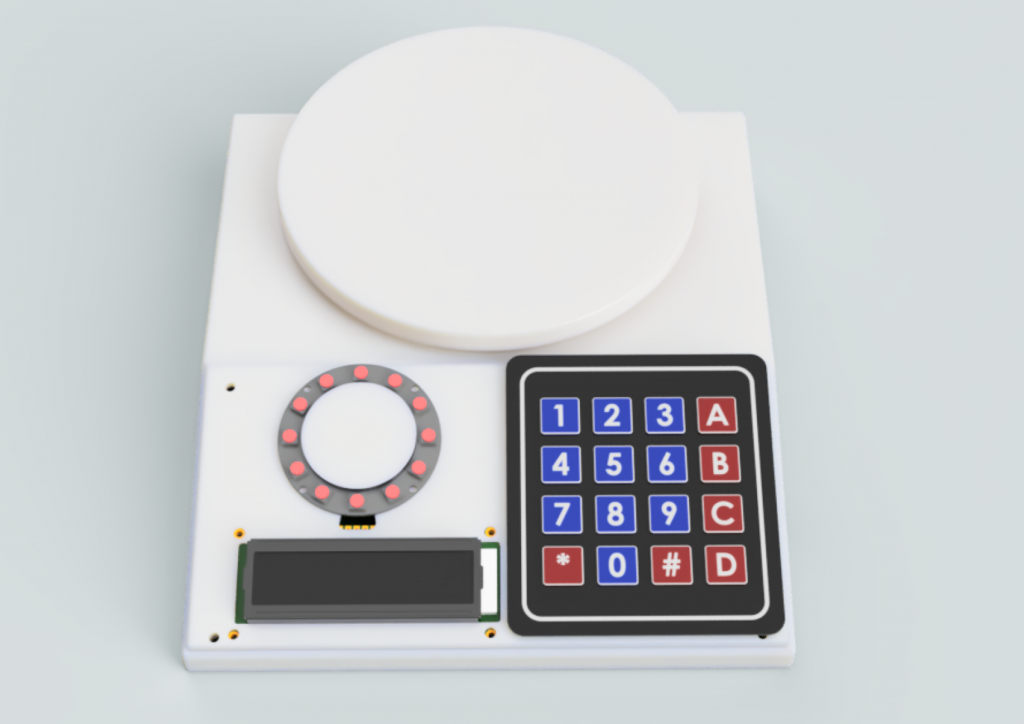
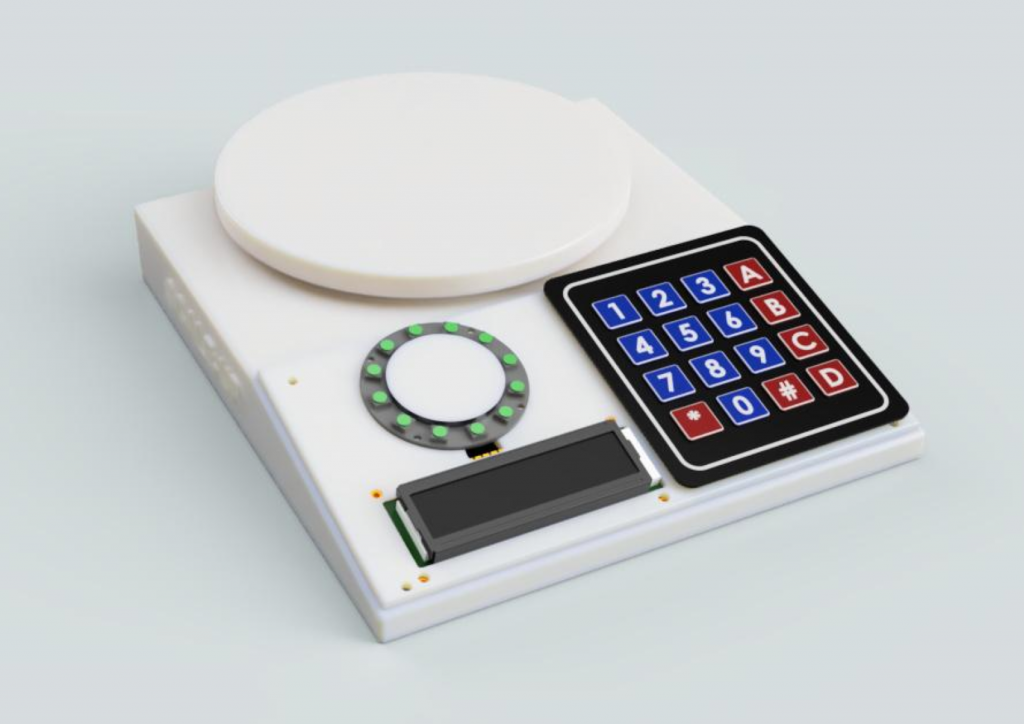
How might we simplify the premixing process so that baking is made accessible to a wider range of participants with intellectual disabilities?
Our team: Bei Rui, Danial, Elakkiya, Yi Xuan
Our mentor: Kiruthika
Project Vision:
Baking is both an art and a science, involving many different cognitive functions. Our project aims to create a specialized weighing scale that is tailored to the unique abilities of people with intellectual disabilities. Innovative tools like this can enable them to actively participate in baking and find independence through sheltered employment opportunities.
Understanding Our Users:
Our end users, who have intellectual disabilities, face cognitive and computing challenges. Processing numbers is difficult for them, so they struggle to calculate the adequacy of weights, making the premixing process challenging. They may not be able to quickly assess whether an ingredient is sufficient in weight, too little, or too much. If the weight is not right, they may have trouble calculating the difference needed to add or remove. However, they can easily understand straightforward and visual instructions. For example, most of them can interpret red as wrong and green as correct. By understanding their unique learning capabilities, we designed a weighing scale suitable for their use.
Current state:
Premixing is currently reserved for a select number of participants with numeracy capabilities. At times, it creates a bottleneck, as many bakers are waiting for 1 or 2 persons to complete the premix step. By simplifying the process, more participants can help with the premix process and expand the production capability of the bakery.
New Innovative Design:
Our project introduces an accessible weighing scale with a system of light indicators for different ingredients. Inspired by “Pick to Light” warehouse systems, the bakery trainer loads the scale with preset recipes and sets the indicator lights against the necessary ingredients. Trainees follow the lights on the scale and shelves, then pour and measure each ingredient in order. At the accessible weighing scale, indicator lights will flash when the desired amount is detected. By relying on automated and visual instructions, trainees can complete the premix process accurately and independently.
Community Partner: MINDS
MINDS is a non-profit organisation dedicated to providing a wide range of services for persons with intellectual disabilities (PWIDs) and their families, aimed at helping them participate in society. MINDS believes that every individual with special needs has innate talents and strengths that can be nurtured.
MINDS Bakers started as a therapy program designed to improve cognitive skills and promote social integration, but it has now grown into a thriving social enterprise that offers employment and training opportunities for adults with intellectual disabilities who have a passion for baking. Certified bakers create sweet treats for various events, including corporate events, birthdays, and weddings. The goal of MINDS Bakers is to empower individuals with intellectual disabilities, provide them with a supportive work environment, and help them develop valuable skills in the food and beverage industry.
During discussions on how to better adapt processes for PWIDs, the staff at MINDS Bakers sought to simplify various tasks throughout the baking process, such as measuring cookie packages, which currently requires a firm grasp of numeracy.
Innovators will create assistive devices that complement the bakery’s standard operating procedures (SOPs) and the talents of the MINDS Bakers, with the aim of making the food and beverage industry more open and accessible to PWIDs.
Rapid Ascend Mobile Platform (R.A.M.P.)
by Team Wzeals
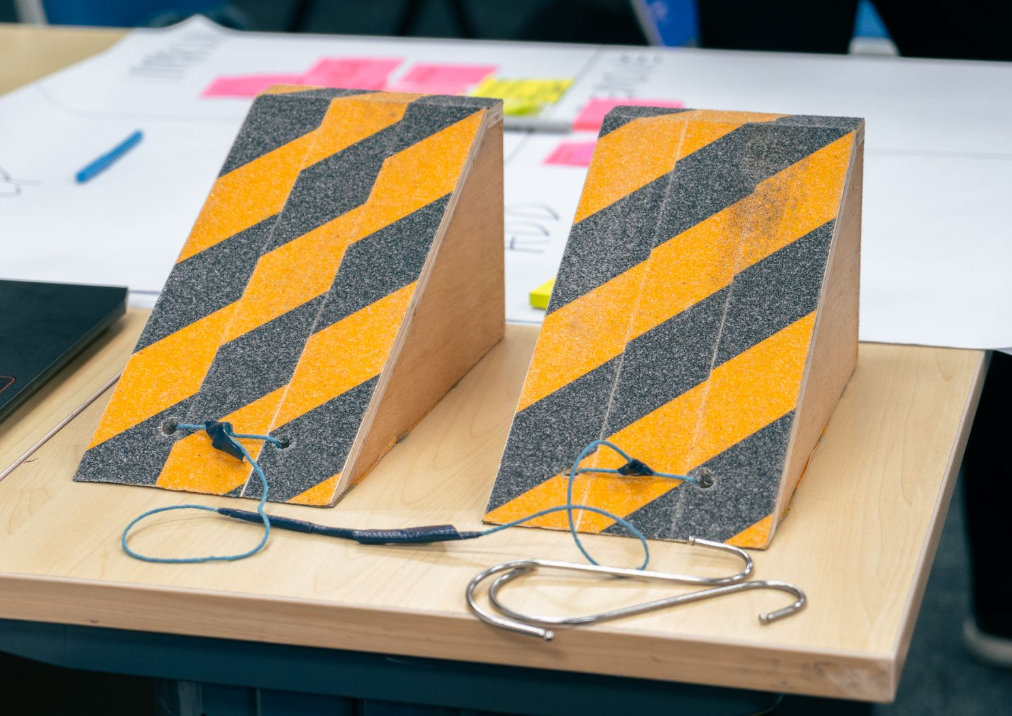
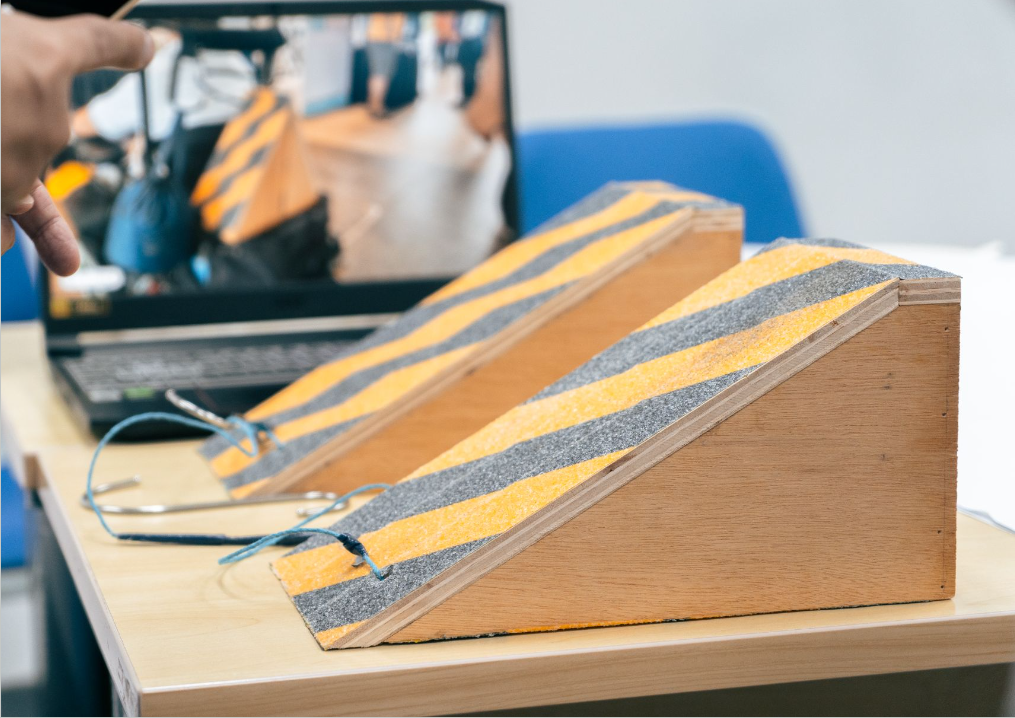
How might we empower persons with physical disabilities to effortlessly navigate the barriers along their daily commutes with low-tech and accessible solutions?
Our team: Zng Hiong, Qi Yuan, Ananya, Mikil
Our mentor: Poon Kin
Project Vision:
Adapting market-available products to be used by Alister was the key strategy in overcoming the barriers he faced. This would ensure the solutions would be affordable and accessible to many different people.
Understanding Our Users:
Alister is a determined individual who faces the daily challenges of Spastic/Dyskinetic Cerebral Palsy. This condition causes discomfort and restricts his range of motion due to tight muscles. Alister experiences difficulty walking due to the tightness in his hip and leg muscles, which tend to pull his legs inward. He also finds it difficult to fully extend his arms to reach lift buttons and tap his card at gantries or doors.
Current state:
Alister relies on a motorized wheelchair for mobility, which has a seat height of approximately 50.5 cm. At this height and range of motion, he cannot comfortably reach some card readers to open doors/gantries or press lift buttons independently. As a regular commuter to the Central Business District (CBD), he often encounters high curbs, steps at building entrances, access card gantries at building lobbies, and unsheltered pathways. To overcome these obstacles, he sometimes needs to drive around buildings to enter through loading bays. Other times, he must wait for helpful passers-by to assist in pressing lift buttons or opening doors for him.
New Innovative Design:
To assist Alister in independently overcoming the obstacles he faces, we explored modifying and adapting market-available products. This approach helps keep the solutions affordable and increases accessibility for other wheelchair users.
- Triangular block: an off-the-shelf solution for cars and bicycles to overcome curbs can aid wheelchairs to climb curbs up to a height of 110mm. A mechanism to assist individuals in placing the block while remaining seated is to be developed for the user.
- Rain cover: a deployable rain sheet that offers basic protection against mild rain for both the user and the wheelchair’s electronic components. To make this product accessible, we will modify the opening mechanism to be within reach of the user.
- Touch N Go rods: designed for drivers to access payment kiosks using their payment cards. However, these lightweight rods are also useful for wheelchair users to extend their reach to door access systems, electronic gantries, and lift buttons. To make it easier for the user, the rod needs to be attached to the wheelchair in a proper holder that is within reach but does not affect the user’s comfort.
Community Partner: Alister Ong
Merging valuable experience with a degree in economics, Alister is a globally recognised disability advocate. He has given talks at J.P Morgan, Bloomberg, Boehringer Ingelheim, LinkedIn, Uber, Sleek, and more. He aims to facilitate positive growth by providing a robust Diversity and Inclusion Strategy through thought leadership and change management.
Alister is a recipient of the Goh Chok Tong Enable Award and currently leads the Diversity Equity Inclusion Client Solutions team at Michael Page. He is also a Keynote Speaker for the National Council of Social Services (NCSS) and the Purple Parade Vice Chairperson.
Alister lives with Cerebral Palsy (CP) which affects movement and posture. CP is caused by illness or injury to the brain before or during birth, or early in life. He hopes to see more barrier-free access paths and signage for wheelchair users in Singapore. As a motorised wheelchair user, his commute to the Central Business District is fraught with environmental barriers, such as the lack of ramps, small curbs, the inability to shelter himself from the rain, and automatic gantries that require him to tap a card.
Innovators will work with Alister to create assistive devices that can reduce commuting barriers, allowing people with physical disabilities to spend quality time in the office.
SeedVantage
by Team SAAC Farmers
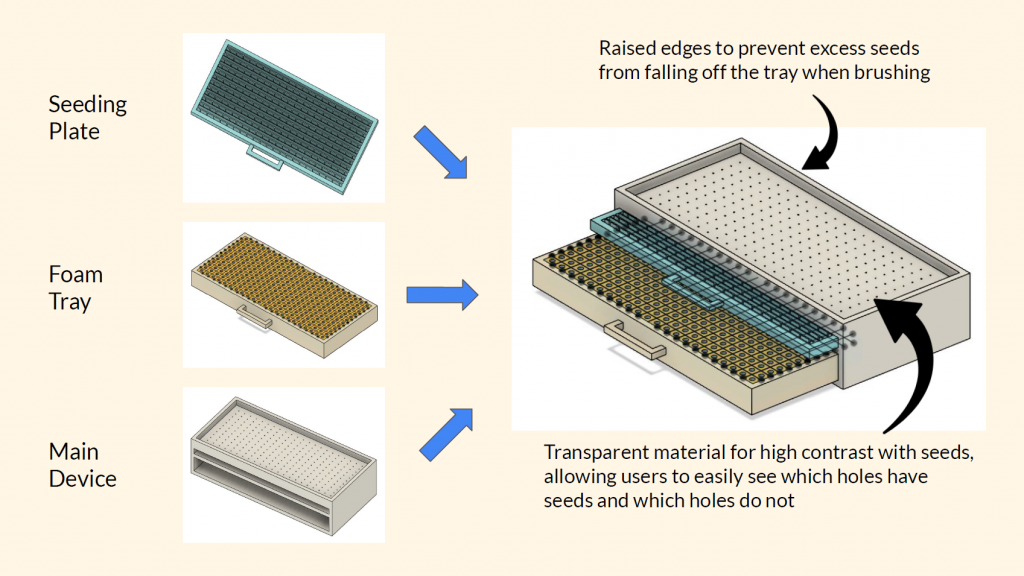
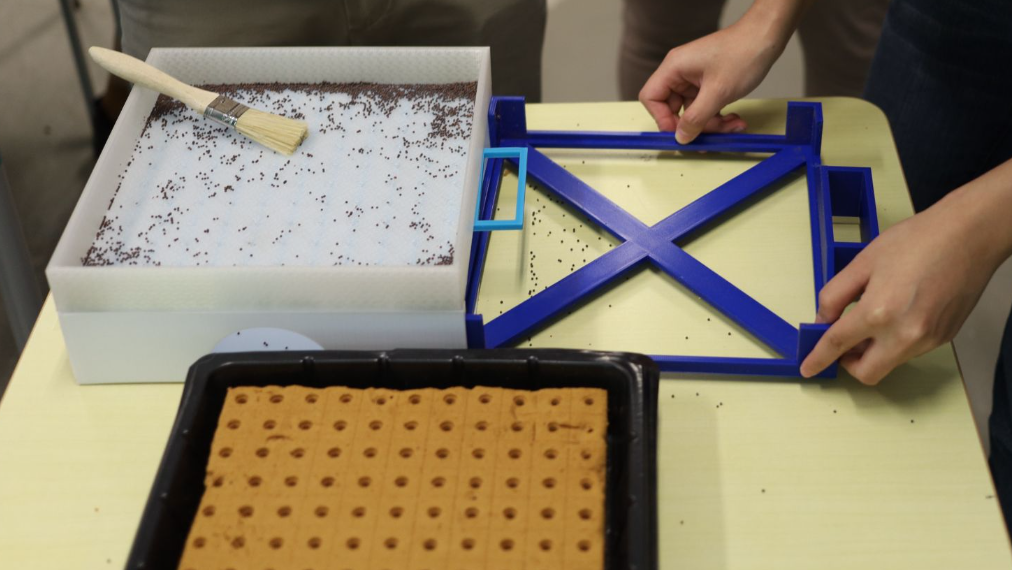
How might we make the seeding process for germination more efficient and autism-friendly?
Our team: Chime, Andrew, Avellin, Huiqi, Koji, Lian See
Project Vision:
Our goal is to simplify the seeding process, allowing more individuals with autism to complete this stage independently and efficiently. We are reshaping the experience to better suit their abilities and make the process comfortable for them to repeat again and again.
Understanding Our Users:
Persons with autism possess unique strengths and face specific challenges. We recognise their attention to detail, methodical approach, and proficiency in repetitive tasks. To address their challenges such as verbal impediments, motor skill limitations, and cognitive impairments, our design prioritises simplicity and minimal steps.
Current state:
There are currently 2 methods of seeding used and explored by farmers:
- Using tweezers to pick up and drop 1-2 seeds into every hole (242 holes per tray!) on the foam tray, which requires good fine motor, visual tracking skills, and prolonged focus.
- Using a vacuum, seeds are drawn into the top plate’s holes and released into a foam tray when the device is flipped. Lifting and flipping over the heavy vacuum chamber is a challenge for those without developed strength and support. This may fatigue the end users quickly.
New Innovative Design:
A seeding device that features an array of holes, each capable of holding 2-3 seeds. By integrating a foam tray aligned with these seeding holes, the seeds can be poured over the tray and evenly dispersed using a brush. Pulling the plate releases the seeds into the foam tray, making the process efficient and user-friendly.
Community Partner: St. Andrew's Autism Centre (SAAC)
SAAC provides education, training, care, and residential services for individuals with moderate to severe autism. They also equip families and caregivers with skills and engage in public education and outreach for an inclusive society.
SAAC’s Dignity of Work program teaches horticulture tasks such as germination, transplanting, and harvesting to vocational and pre-vocational students and adult clients. This programme cultivates valuable life and work skills like teamwork and scheduling. The produce is sold to restaurants and families, giving clients a chance to contribute to society.
Maintaining and caring for a hydroponics farm is not easy. Persons with autism may face additional challenges in communication and social interaction, sensitivity to sensory stimulation, and repetitive behaviour. To facilitate learning, the hydroponics farm process is broken down into systematic steps.
Innovators will explore solutions with SAAC to make hydroponics farming more ASD-friendly and create a more inclusive industry.

